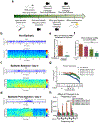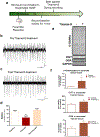Human and rodent temporal lobe epilepsy is characterized by changes in O-GlcNAc homeostasis that can be reversed to dampen epileptiform activity
- PMID: 30625365
- PMCID: PMC6379093
- DOI: 10.1016/j.nbd.2019.01.001
Human and rodent temporal lobe epilepsy is characterized by changes in O-GlcNAc homeostasis that can be reversed to dampen epileptiform activity
Abstract
Temporal Lobe Epilepsy (TLE) is frequently associated with changes in protein composition and post-translational modifications (PTM) that exacerbate the disorder. O-linked-β-N-acetyl glucosamine (O-GlcNAc) is a PTM occurring at serine/threonine residues that is derived from and closely associated with metabolic substrates. The enzymes O-GlcNActransferase (OGT) and O-GlcNAcase (OGA) mediate the addition and removal, respectively, of the O-GlcNAc modification. The goal of this study was to characterize OGT/OGA and protein O-GlcNAcylation in the epileptic hippocampus and to determine and whether direct manipulation of these proteins and PTM's alter epileptiform activity. We observed reduced global and protein specific O-GlcNAcylation and OGT expression in the kainate rat model of TLE and in human TLE hippocampal tissue. Inhibiting OGA with Thiamet-G elevated protein O-GlcNAcylation, and decreased both seizure duration and epileptic spike events, suggesting that OGA may be a therapeutic target for seizure control. These findings suggest that loss of O-GlcNAc homeostasis in the kainate model and in human TLE can be reversed via targeting of O-GlcNAc related pathways.
Keywords: Electroencephalogram; Electrophysiology; Hippocampus; Magnetic resonance imaging; Mass spectrometry; O-GlcNAcylation; Post-translational modification; Thiamet-G.
Copyright © 2019 Elsevier Inc. All rights reserved.
Figures






References
-
- Liu XY, et al., Comparative proteomics and correlated signaling network of rat hippocampus in the pilocarpine model of temporal lobe epilepsy. Proteomics, 2008. 8(3): p. 582–603. - PubMed
-
- Meriaux C, et al., Human temporal lobe epilepsy analyses by tissue proteomics. Hippocampus, 2014. 24(6): p. 628–42. - PubMed
-
- Gass P, Kiessling M, and Bading H, Regionally selective stimulation of mitogen activated protein (MAP) kinase tyrosine phosphorylation after generalized seizures in the rat brain. Neurosci Lett, 1993. 162(1–2): p. 39–42. - PubMed
-
- Mielke K, et al., Activity and expression of JNK1, p38 and ERK kinases, c-Jun N-terminal phosphorylation, and c-jun promoter binding in the adult rat brain following kainate-induced seizures. Neuroscience, 1999. 91(2): p. 471–83. - PubMed
Publication types
MeSH terms
Substances
Grants and funding
LinkOut - more resources
Full Text Sources
Other Literature Sources
Molecular Biology Databases
Miscellaneous

